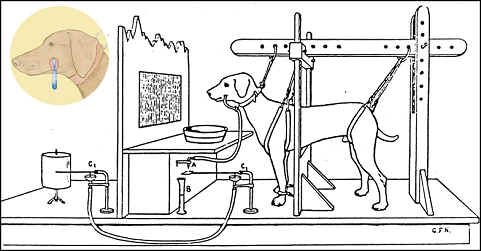
Psy 342 Learning & Memory
Chapter 3
Basic Principles of Classical Conditioning
I. Pavlov’s Experiments

What was the unconditioned stimulus?
What was the unconditioned reflex (or response)?
What was the conditioned stimulus?
What was the conditional reflex (or response)?
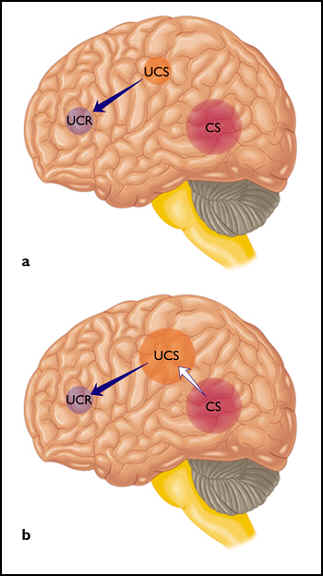

II. Classical Conditioning Terminology
A. Unconditioned Stimulus (US)
An event that consistently and automatically elicits an unconditioned response
B. Unconditioned Response (UR)
An action that the unconditioned stimulus automatically elicits
C. Conditioned Stimulus (CS)
Initially a neutral stimulus. After repeated pairings with the unconditioned stimulus, the CS elicits the same response as the US.
D. Conditioned Response (CR)
The response elicited by the conditioned stimulus due to the training.
Classical conditioning is a method used to study associative learning. What is
an association?
III.
Examples of Classical Conditioning
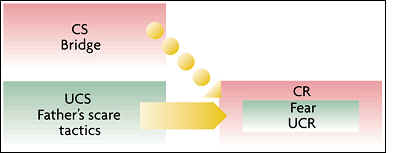

IV. Contingency
A. Positive Contingency
Two stimuli tend to occur together and neither tends to occur when the other is absent
Classical excitatory conditioning
B. Negative Contingency
One stimulus regularly precedes the absence of another stimulus that is present at other times
Classical inhibitory conditioning
C. No Contingency
The CS is NOT a reliable signal for the occurrence or absence of a US
Would you predict classical conditioning to occur in this situation?
V. Methods
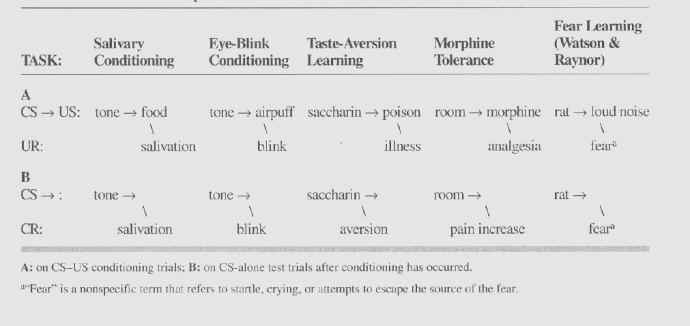
A. Human Conditioning Paradigms
Most often studied in
humans—Eye blink reflex and skin conductance response

Classical conditioning of the eye-blink response
SCR—A measure of the electrical conductivity of the skin, which varies with subtle changes in the subject's emotionality
Animal paradigms must be suited to the behavioral repertoire of the particular species
Rabbits—nictitating membrane paradigm—like eye blink conditioning paradigm in humans
A couple of classical conditioning methods use less traditional USs (stimulus doesn't elicit reflexive response and/or responses are measured indirectly.
Conditioned Taste Aversion--
CS--
US--
UR--
CR--
VI.
Relationship
between CS and US
How are CS and US
arranged in time
A. Temporal Order--What is the role of contiguity?

Why is there such a difference between forward (delayed
& trace) versus simultaneous and backward pairings?
B. CS-US Interval

What is the range of optimal CS-US intervals?
**Conditioned taste aversion is an exception
C. Number of CS-US Pairings
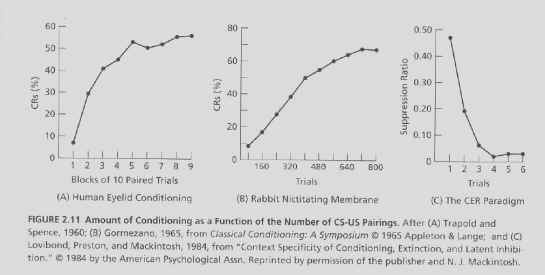
Learning/Acquisition curves reflect ________________?
D. Prior Experience with CS or US
How does our experience with a CS or a US affect the degree to which these
stimuli will promote conditioning?
latent inhibition—Pre-exposures to a CS alone can hinder later conditioning involving that CS (Lubow & Moore, 1959)
Possible explanations:
habituation
interference
E. CS-US Relevance
Are the CS and US typically related in the natural environment?
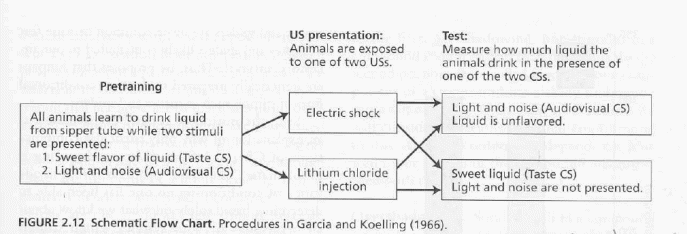

For the US of shock, the more salient CS was ______________?
For the US of poison, the more
salient CS was ______________?
Seligman (1970)--genetic preparedness
F. Presence of Other Stimuli During
Conditioning
Compound Conditioning
When two or more conditioned stimuli occur together before the US, each may become conditioned but to varying degrees
What's the basic compound procedure?
Training
Test Compound
Test individual CSs
Which CS
acquires more conditioning and which acquires less can be altered in
several ways:
1. Overshadowing
The general perceived strength of stimuli is commonly
referred to as their salience. Although it might be related to the physical
measurable intensity of stimuli, salience refers to the intensity of the
subjective experience of stimuli, not of the objective intensity of the stimuli
themselves. Salience, as subjective experience, varies between individuals, and,
more importantly, between species. Salience depends on some combination of
the physical characteristics of stimuli and of the sensory systems of the
perceiver.
2. Onset of CSs--Egger and Miller (1963)--salivary conditioning with dogs
Blocking
Kamin (e.g., 1969)
Why was conditioning to the added stimulus blocked?
VII. Conditioning Without an
Explicit US
Conditioning can take place in some cases EVEN WHEN NO EXPLICIT US APPEARS TO BE PRESENT

Higher Order Conditioning
Second-Order Conditioning--When conditioning results from the pairing of a novel CS with a previously
conditioned CS (a form of
higher order conditioning)
Sensory Preconditioning
Sensory preconditioning first involves the paring of two CSs. Later, when one of the stimuli is paired with a US and becomes capable of producing a CR, the organism reacts to the other CS as if it, too, had been paired with the US.
XI. Extinction
The decrease and eventual disappearance of a conditioned response once a CS is no longer a reliable signal for a US
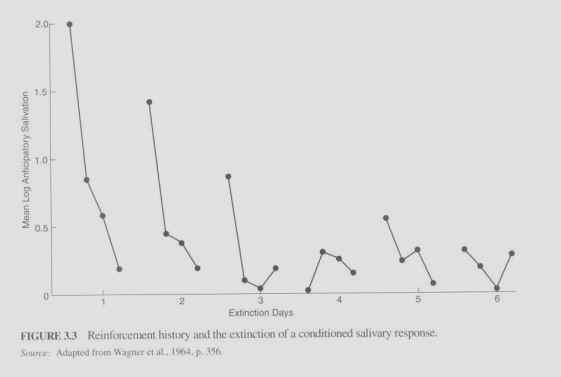
Researchers have argued about the precise mechanism that controls extinction.
Research shows that:
Extinction does NOT RESULT FROM
FORGETTING
Extinction does NOT INVOLVE LOSS of THE ASSOCIATION formed during conditioning
What is spontaneous recovery of the response?

How
do these variables affect the rate of extinction?
(1) Number of CS-US conditioning trials presented during actual conditioning
XII. Application of Classical Conditioning Procedures
A. Watson & Rayner (1920)
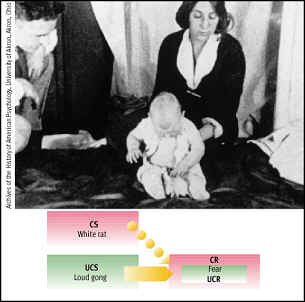
§ B. Extinction procedures for treatment of some phobias
Extinction as therapy
Systematic desensitization